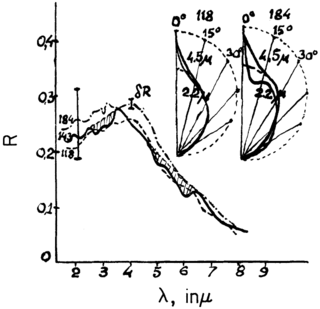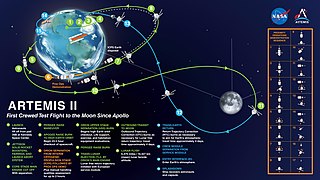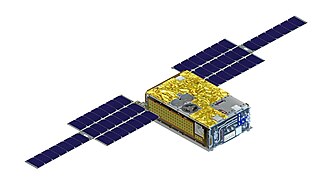
Lunar water is water that is present on the Moon. Diffuse water molecules in low concentrations can persist at the Moon's sunlit surface, as discovered by the SOFIA observatory in 2020. Gradually, water vapor is decomposed by sunlight, leaving hydrogen and oxygen lost to outer space. Scientists have found water ice in the cold, permanently shadowed craters at the Moon's poles. Water molecules are also present in the extremely thin lunar atmosphere.

Artemis 1, officially Artemis I and formerly Exploration Mission-1 (EM-1), was an uncrewed Moon-orbiting mission. As the first major spaceflight of NASA's Artemis program, Artemis 1 marked the agency's return to lunar exploration after the conclusion of the Apollo program five decades earlier. It was the first integrated flight test of the Orion spacecraft and Space Launch System (SLS) rocket, and its main objective was to test the Orion spacecraft, especially its heat shield, in preparation for subsequent Artemis missions. These missions seek to reestablish a human presence on the Moon and demonstrate technologies and business approaches needed for future scientific studies, including exploration of Mars.

Artemis 2 is a scheduled mission of the NASA-led Artemis program. It will use the second launch of the Space Launch System (SLS) and include the first crewed mission of the Orion spacecraft. The mission is scheduled for no earlier than September 2025. Four astronauts will perform a flyby of the Moon and return to Earth, becoming the first crew to travel beyond low Earth orbit since Apollo 17 in 1972. Artemis 2 will be the first crewed launch from Launch Complex 39B of the Kennedy Space Center since STS-116 in 2006.

The Near-Earth Asteroid Scout was a mission by NASA to develop a controllable low-cost CubeSat solar sail spacecraft capable of encountering near-Earth asteroids (NEA). NEA Scout was one of ten CubeSats launched into a heliocentric orbit on Artemis 1, the maiden flight of the Space Launch System, on 16 November 2022.

Lunar Flashlight was a low-cost CubeSat lunar orbiter mission to explore, locate, and estimate size and composition of water ice deposits on the Moon for future exploitation by robots or humans.

BioSentinel is a lowcost CubeSat spacecraft on a astrobiology mission that will use budding yeast to detect, measure, and compare the impact of deep space radiation on DNA repair over long time beyond low Earth orbit.

Lunar IceCube is a NASA nanosatellite orbiter mission that was intended to prospect, locate, and estimate amount and composition of water ice deposits on the Moon for future exploitation. It was launched as a secondary payload mission on Artemis 1, the first flight of the Space Launch System (SLS), on 16 November 2022. As of February 2023 it is unknown whether NASA team has contact with satellite or not.

LunIR is a nanosatellite spacecraft launched to the Moon collecting surface spectroscopy and thermography. It was launched as a secondary payload on the Artemis 1 mission on 16 November 2022.

CubeSat for Solar Particles (CuSP) was a low-cost 6U CubeSat to orbit the Sun to study the dynamic particles and magnetic fields. The principal investigator for CuSP is Mihir Desai, at the Southwest Research Institute (SwRI) in San Antonio, Texas. It was launched on the maiden flight of the Space Launch System (SLS), as a secondary payload of the Artemis 1 mission on 16 November 2022.

ArgoMoon is a CubeSat that was launched into a heliocentric orbit on Artemis 1, the maiden flight of the Space Launch System, on 16 November 2022 at 06:47:44 UTC. The objective of the ArgoMoon spacecraft is to take detailed images of the Interim Cryogenic Propulsion Stage following Orion separation, an operation that will demonstrate the ability of a cubesat to conduct precise proximity maneuvers in deep space. ASI has not confirmed nor denied whether this took place, but several images of the Earth and the Moon were taken.
Cislunar Explorers is a pair of spacecraft that will show the viability of water electrolysis propulsion and interplanetary optical navigation to orbit the Moon. Both spacecraft will launch mated together as two L-shaped 3U CubeSats, which fit together as a 6U CubeSat of about 10 cm × 20 cm × 30 cm.

Earth Escape Explorer (CU-E3) is a nanosatellite of the 6U CubeSat format that will demonstrate long-distance communications while in heliocentric orbit.
Team Miles was a 6U CubeSat that was to demonstrate navigation in deep space using innovative plasma thrusters. It was also to test a software-defined radio operating in the S-band for communications from about 4 million kilometers from Earth. Team Miles was one of ten CubeSats launched with the Artemis 1 mission into a heliocentric orbit in cislunar space on the maiden flight of the Space Launch System (SLS), that took place on 16 November 2022. Team Miles was deployed but contact was not established with the spacecraft.

EQUULEUS is a nanosatellite of the 6U CubeSat format that will measure the distribution of plasma that surrounds the Earth (plasmasphere) to help scientists understand the radiation environment in that region. It will also demonstrate low-thrust trajectory control techniques, such as multiple lunar flybys, within the Earth-Moon region using water steam as propellant. The spacecraft was designed and developed jointly by the Japan Aerospace Exploration Agency (JAXA) and the University of Tokyo.

OMOTENASHI was a small spacecraft and semi-hard lander of the 6U CubeSat format intended to demonstrate low-cost technology to land and explore the lunar surface. The CubeSat was to take measurements of the radiation environment near the Moon as well as on the lunar surface. Omotenashi is a Japanese word for "welcome" or "Hospitality".

CAPSTONE is a lunar orbiter that is testing and verifying the calculated orbital stability planned for the Lunar Gateway space station. The spacecraft is a 12-unit CubeSat that is also testing a navigation system that is measuring its position relative to NASA's Lunar Reconnaissance Orbiter (LRO) without relying on ground stations. It was launched on 28 June 2022, arrived in lunar orbit on 14 November 2022, and was scheduled to orbit for six months. On 18 May 2023, it completed its primary mission to orbit in the near-rectilinear halo orbit for six months, but will stay on this orbit, continuing to perform experiments during an enhanced mission phase.

Small Innovative Missions for Planetary Exploration (SIMPLEx) is a planetary exploration program operated by NASA. The program funds small, low-cost spacecraft for stand-alone planetary exploration missions. These spacecraft are intended to launch as secondary payloads on other missions and are riskier than Discovery or New Frontiers missions.


















